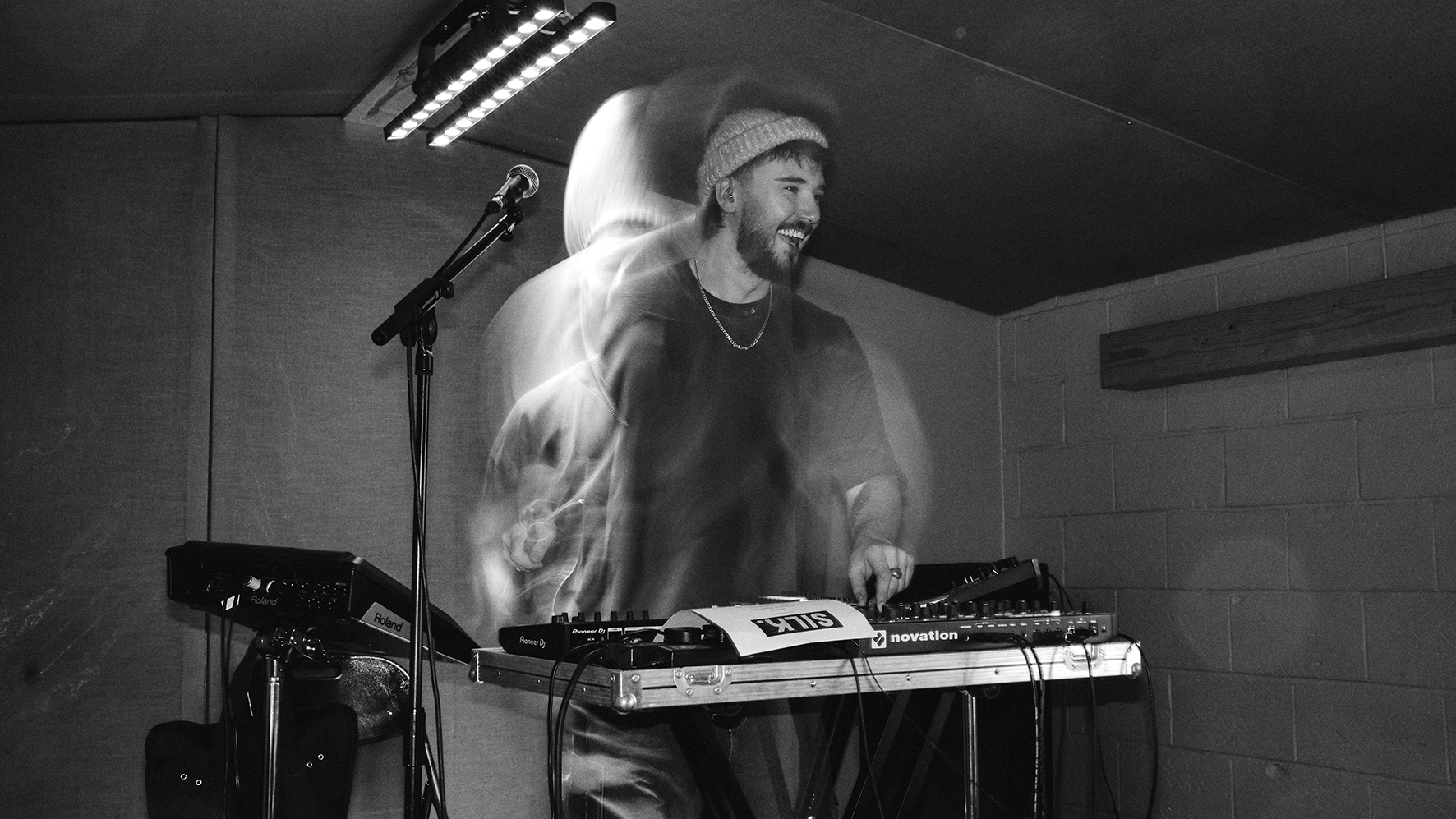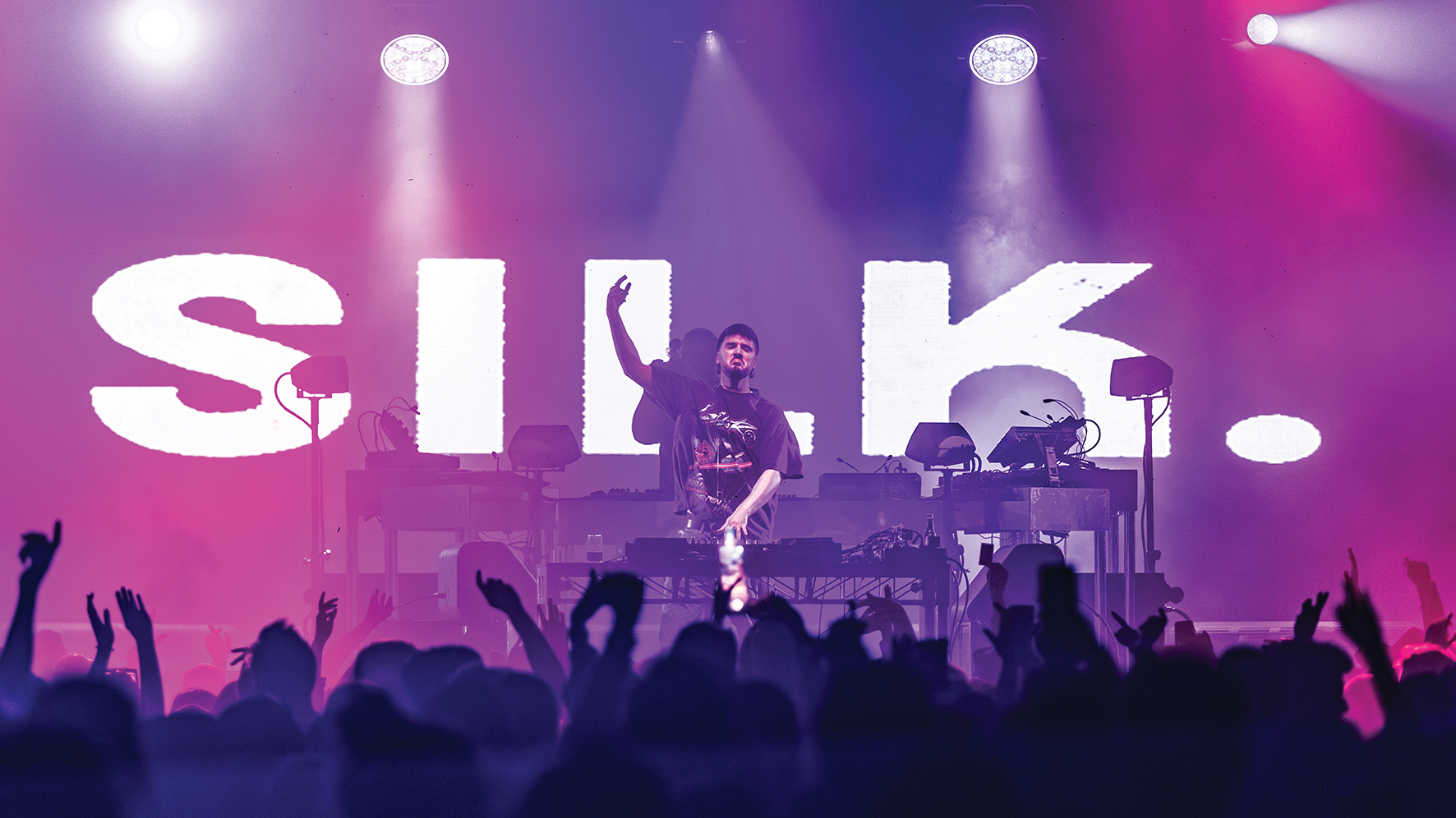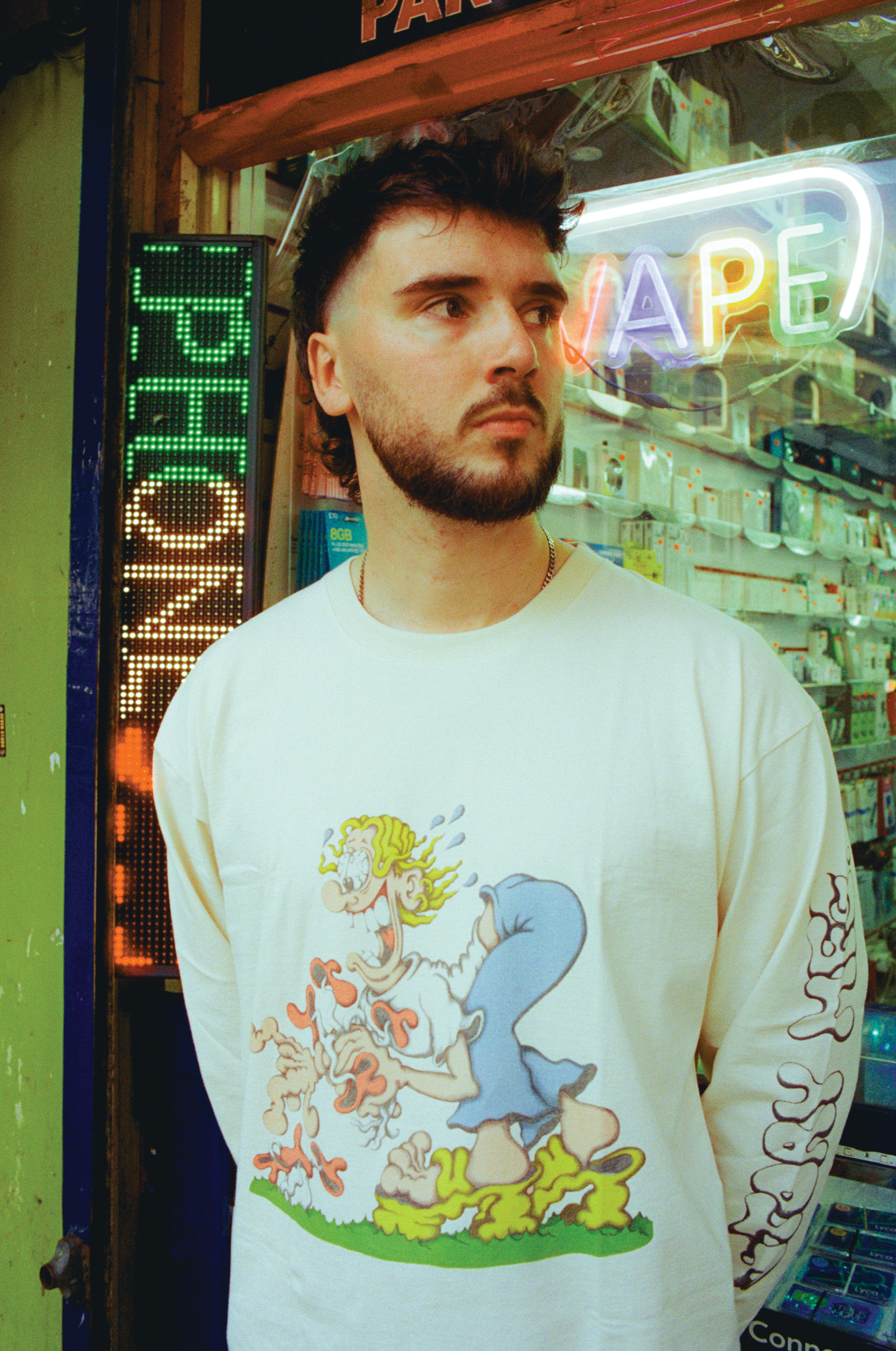
For better and for worse, the relationship between modern music artists and social media is intertwined, meaning that while small-scale DIY artists can suddenly achieve global success and generate massive audiences overnight, the requirement to have such a self-built, ready-to-go audience can now be the barometer on which major labels take an interest.
Alongside that demand, there’s the cold reality that a lack of instant feedback, or positive engagement, can have detrimental effects on the mental health of artists who are still developing. It’s a situation that SILK (real name Olly Ettridge) knows all too well. “I might post TikToks and they might not get as many likes as the [2022 single] Quiver one did,” he says, “and you feel like shit about it. But, are you going to let your success be governed by that? It’s really damaging.”
I had this chord progression and basically finished Quiver on a two-hour train journey [...] I woke up the next day and it had like a million views
But while Olly had been naturally frustrated by the lack of response social media would sometimes give to tracks he’d spent months working on, it would also be instrumental to his success. As with the aforementioned, sublime Quiver, “I had this chord progression and basically finished Quiver on a two-hour train journey.“
“I pulled in and thought ‘I’m just going to post it online’. I thought people might not like it as it’s a bit different to what I’d done before. But at the end of it I decided ‘I don’t care, I’m doing it’. I woke up the next day and it had like a million views. It was a really crazy moment. I realised we’d found something that landed.”
Before long, SILK was sitting pretty atop 55 million TikTok views, 35 million catalogue streams and a euphoric summer tour in Australia and New Zealand alongside Australian DJ Golden Features. He saw out 2023’s Leeds Festival in front of 25,00 punters, and, in September, sold out his first headline London show.
Supply the love
Let’s rewind the clock a little, to the very beginning of Olly’s journey. We wonder if music had been a prominent part of his childhood? “I’ve always kind of been into music from a very young age,” Olly says, “I was obsessed with dance and indie stuff growing up. I started making music when I was about 10 years old. I went to Denmark Street and I bought my first interface and a MIDI keyboard, which I still use from time to time. I started from there, experimenting with all the bands I was in, trying to record some of our music.
“I went through that phase up until I was about 17, then when I got to college I got way more into dance music. I thought ‘I’m going to have a crack at this’. I was doing music production at college as well so it kind of went hand-in-hand. My teachers Justin and Jason were really into dance music as well, so when I told them that this was what I wanted to do they really helped me.”
It was at college that the SILK project was born, as Olly began digging into heavy bassline-driven music. “I did that as a hobby all the way up to being 21. My soon-to-be manager moved to Watford quite close to me. She was managing Sammy Virji at the time who was quite big in the bassline scene. I figured out that she was his manager and then found out she lived just down the road. I invited her for a drink and played some of my music.

“It probably sucked at the time, but luckily we became friends and that was a secondary thing. When it got to the point when she thought she could help me out, she took me on. That continued until I was about 23 with the bassline/garage thing.” Unfortunately, Olly’s sound didn’t seem to be finding an audience. “You just know when things aren’t really going anywhere? Basically my tunes were getting better but the scene itself was tricky to navigate. I noticed that pretty early on, luckily.”
It was only relatively recently that Olly decided to take time out from his then-job, and focus entirely on making it as an artist. If this still didn’t yield results, he’d abandon his ambitions forever. “When it got to the end of last 2022,” he admits, “I said to myself ‘I’m going to give it one last crack’. If that didn’t work I’d probably move on and do something else. It’s been a long time to be working on it.”
My tunes were getting better but the scene itself was tricky to navigate
Taking a six-month sabbatical from his job, Olly locked himself in his room, stopped going out and invested every fibre of his being into making the best tracks he could. “I thought, I’m just going to do everything in my power to drain my creative juices and see what I can get out of this. Two months in, I had a fair amount of music that was there and I was happy with. TikTok was exploding and it kind of went hand-in-hand. I thought I’d do anything to get it out there so started studying its algorithm.”
During that time, SILK made Supply the Love, a joyous, hands-in-the-air disco banger, that heavily sampled Toto’s I’ll Supply the Love. “Once I started getting a bit of traction on TikTok a few labels became interested. I had a few meetings. Nothing really felt right at the start, but I was very excited. I had a first version of Supply the Love, that was the one that turned some heads. They wanted to hear more.”

Meeting an A&R from EMI, Olly was delighted to find a kindred spirit: “We had very similar music tastes, so what I was doing just clicked with him. We had that mutual respect and common ground and I thought I could see this going the distance. It was explained to me from an early stage that you’ll spend a lot of time with these people. To build the project up.”
After a three-month period of work, he finally signed with EMI. “Supply the Love came out in October and it did alright – I think we’d left it a little bit too long because we had to get the sample cleared from Toto. It was very long-winded. It was a summer record that came out in October. It was a bit of an anti-climax after all that work. Don’t get me wrong, I think the track has grown and had a bit of life on its own, but obviously labels and people want that initial reaction from the off.”
Its follow-up, however, would turn the heads of some of electronic music’s biggest players…
Cool as silver
With its shimmering vocal, infectious hypnotic rhythm and glimmering synths, Quiver was an unmistakable gem. We wonder how the foundations of the track were built. “Well it took a year for Supply the Love to see the light of day, and a lot had changed since I’d first made it – my production had matured and my taste had changed quite a bit. After that, I was trying to write another disco record. I wasn’t really feeling it. It had kind of been and gone really. I didn’t want to get pigeon-holed. I was writing a lot of Quiver-type stuff at that point, but the song itself came about during that train journey between Bristol and London.”
You start with the bare bones of a track and you then think about things that can ‘live’ in that world
Olly’s track-building approach had shifted significantly from his earlier work: “The approach I had to that, and I think it’s similar to Fred Again..’s approach. I watched his Zane Lowe interview after Quiver came out and it seemed similar. Anyway, it’s an approach where you start with the bare bones of a track and you then think about things that can ‘live’ in that world. You have a base of, say, drones to build out that kind of feeling. I use a similar approach but with other elements.”
Olly explains that building a track like Quiver is essentially about creating a sonic ‘world’ “Essentially, you’re writing a song rather than writing a dance record. That’s the least pretentious way of talking about it! Basically, if you strip Quiver back and you just have the chords and the little floaty elements without the drums and bassline, it would still encapsulate those emotive elements, whereas if you just did a straightforward 4/4 tech house track and take away the bass and kick drum, there’s not really much left.”

“There’s lots of little mix elements,” Olly continues. “There’s a cello in there that you can’t really hear, but you listen to it on its own and it really makes you feel something. Your brain knows its there! But, it’s not straight in your face. You blend all of these things together and they kind of create this texture that just tickles your emotions. It’s quite easy to get caught up in your productions. The [initial] mixdown on Quiver sucked, I don’t know how I let it leave Logic. But it made me feel something at the time. Nobody has complained about it though. You can get caught up in the little things, but for me the most important thing is building those bare bones of the song.”
You can get caught up in the little things, but for me the most important thing is building those bare bones of the song
Following that phenomenal TikTok response, there were a few internal discussions with Silk’s team as to whether it should be put out so soon after Supply the Love, but Olly insisted. “I wanted it out this year. It was seven weeks after that first TikTok that we got everything together and the song was released. December is a bit of a shoddy month to release music as you’re competing with all these Christmas records, it’s just like an industry secret to not release music in that month. But It’s been growing ever since that. That brought us into 2023, and this year’s just been incredible. I’ve had so many amazing opportunities and met so many great people.”
Among the accolades came high praise from the likes of Skrillex, Fred Again... and Disclosure. How does SILK feel about getting the nod from a trio of his heroes? “It’s hard to not let it get away with you, but it is crazy being in the industry and spending time with certain people. You realise how normal a lot of people are; they’re doing exactly what you’re doing but on a different scale. They have an image built around them, but speaking to them is a sobering experience.”
Glitters in gold
We’re curious to find out more about the type of tech that SILK uses in his productions, firstly, we ask about those shimmering vocals in Quiver. “That’s Soundtoys’ Tremolator, baby! The secret sauce!” he laughs. “That is what I use on vocals. There’s so much you can do within that, too. There was no swing originally on Quiver, it was 4/4 straight down the middle. I’ve since become quite good friends with Sammy Virji, with whom I share a label.
“Over the last couple of months he’s been teaching me how to work with swing. He’s a swing god, it just sounds amazing. I’ve been obsessed with that over the last couple of months. It was used on the final version of Quiver, it was used on [recent single] On My Mind. If you look at the beat grids of those tracks in isolation, you’ll see that they’re almost sideways! With the Tremolator on that, there’s a swing function in it, so you can kind of get the vocals to follow those patterns. I’ve been obsessed with that.”
You’re probably going to get way cooler shit out of hardware. But if you know what you want and you know what should be there, then plugins are the way forward
Despite a burgeoning intrigue for hardware synths (triggered by a visit to Australian DJ Golden Features’ studio), Olly keeps largely in-the-box. “The synths used for On My Mind were all in the box. Last Time has some hardware on it, though, including a Korg Minilogue, and Reason has got some hardware-generated arps off the Minilogue. Most of the time I’m working in software, though, typically with Serum or with the Arturia Juno and Prophet emulations. In the future, it’s something I’d like to explore a lot more. I also use Massive quite a bit, just out of pure ease. They’re definitely getting better at replicating classic tones.”
The imperfections with analogue hardware are intriguing to SILK, though: “If you’re experimenting with sounds and trying to get cool stuff out of it, it’s probably better than using software. You’re probably going to get way cooler shit out of hardware. But if you know what you want and you know what should be there, then plugins are the way forward. It’s the way they can interact with everything in your project, too.”
Logic Pro is where Olly perfects his mixes, “Logic is the stew, yes. Everything is done in there; I love it. I think it’s the warmest one. That being said, the warping in Ableton Live is so much better. If I was to help someone starting out making electronic music I’d say learn Ableton. The possibilities are pretty endless in Ableton, but I’m a Logic boy.”
Glitters in gold
We wonder what environment SILK ultimately prefers – the studio-based production process or the hit of a rapturous live audience? “Writing can be quite tedious because 90% of the time it’s rubbish.” SILK explains, “But, I don’t think you can really recreate that 10%, or even 1% where you just feel like you’ve hit on something when writing. That is the best feeling in the world.
You might even be sat in your room and you get an idea. I’ve got ADHD as well so I’ve got something of a hyper-focus. You don’t stop or turn away from your screen for eight hours. You forget to do anything else. But then, when you feel like something clicks, it’s like ‘Oh my god, I’ve done it’. That feeling is the best feeling in the world.”

But, SILK stresses, the live experience can be equally thrilling: “They’re two very different kinds of things. It’s like serotonin and dopamine. I would say it’s dopamine playing live, but it’s serotonin writing in the studio. I’m so obsessed with the live show. It’s such an engaging experience.
“I supported SG Lewis on tour back in March early this year. I remember seeing him doing his thing live and the reaction was great. It’s like seeing a band and seeing a DJ. At a rave you might have people who have their backs turned to the DJ, which is fine. That’s the way that world is designed. But when you’re watching a live act, the engagement is just 10 times more. I’ve been obsessed with that since I saw him in March. I watched his show every night when I was with him.”
Find the lane that you’re comfortable in. If that lane doesn’t exist yet – make it!
Imagining how his tracks will translate to the stage is a big concern, and underpinned the writing of recent single On My Mind, which he wrote with JIM. “I love how that song came about. Again, it was just a chord progression. That was pretty quick-fire. I wrote it just before Australia with these guys from Germany. It was just one of those things that came about just like that. We wanted something for the live show that fit the bill of being a ‘middle-of-set’ happy peak. I was doing half support and half headline shows dotted around Australia. For the support shows, you want that moment that builds.”
Olly has come a long way in a short period of time, and came very close to abandoning his aspirations of achieving the kind of success he now enjoys. When asked what he’s learned – and what wisdom he’d impart to the next wave – Olly takes a pause. “First of all, stick at it. Second of all, find the lane that you’re comfortable in. If that lane doesn’t exist yet – make it! The Spotify gods, wherever they may be, and people that got hold of Quiver early, were saying ‘this is so new, this is a new genre of emotional dance’. I was just like, ‘I don’t know what you’re talking about’. My idea was to merge the things like The 1975 and Skrillex and make something between those two worlds.”
This focus on being true to whatever resonates with you personally is something that Olly can attest to. Though he still feels there’s a way to go in many respects, “I find myself in a position where I’m still trying to prove myself as I’ve only got four tracks out there at the moment and a few remixes.” Olly admits.
“I’m hoping to get an album done soon, it’s on the cards – hopefully next year. We’ll see how the EP goes, which is out in February/March. Depending on how it lands we’ll see. I’ve still got a lot to prove, but finding something I’m passionate about means you don’t care as much beyond writing – If you’re aiming to please other people it’s going to be very disheartening.”
Treat your [social media] content separate to your art – they are not the same thing
The mental health effect that is placed on new artists to build their audience is a big concern of Olly’s. “If I was to go up and do a seminar on an aspect of the music industry at the moment,” he says, “the title would be ‘Your content isn’t your art’. One of my upcoming tracks is my favourite thing I’ve ever written, and you need to get yourself into that mindset. We’re living in such a passive environment at the moment, and one week to the next it’s different. If you want to build an artist project and have fruitful, long careers – then don’t think about that reaction.”
That being said, Olly is confident that the good stuff will find its way to the top: “Good songwriting will prevail. Treat your [social media] content separate to your art – they are not the same thing. If you’re a musician then your content to promote your art isn’t the same thing [as your art]. Do not put them in the same category or you will go crazy.
“Ultimately, by keeping your head down and focused on music you can yield better results.”







